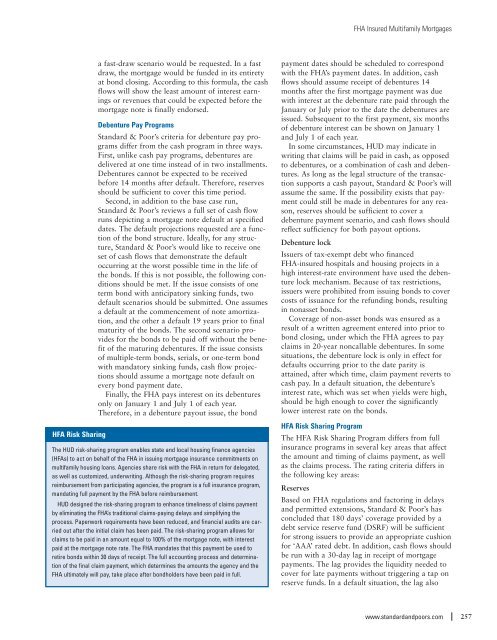S&P - Public Finance Criteria (2007). - The Global Clearinghouse
S&P - Public Finance Criteria (2007). - The Global Clearinghouse
S&P - Public Finance Criteria (2007). - The Global Clearinghouse
You also want an ePaper? Increase the reach of your titles
YUMPU automatically turns print PDFs into web optimized ePapers that Google loves.
FHA Insured Multifamily MortgagesHFA Risk Sharinga fast-draw scenario would be requested. In a fastdraw, the mortgage would be funded in its entiretyat bond closing. According to this formula, the cashflows will show the least amount of interest earningsor revenues that could be expected before themortgage note is finally endorsed.Debenture Pay ProgramsStandard & Poor’s criteria for debenture pay programsdiffer from the cash program in three ways.First, unlike cash pay programs, debentures aredelivered at one time instead of in two installments.Debentures cannot be expected to be receivedbefore 14 months after default. <strong>The</strong>refore, reservesshould be sufficient to cover this time period.Second, in addition to the base case run,Standard & Poor’s reviews a full set of cash flowruns depicting a mortgage note default at specifieddates. <strong>The</strong> default projections requested are a functionof the bond structure. Ideally, for any structure,Standard & Poor’s would like to receive oneset of cash flows that demonstrate the defaultoccurring at the worst possible time in the life ofthe bonds. If this is not possible, the following conditionsshould be met. If the issue consists of oneterm bond with anticipatory sinking funds, twodefault scenarios should be submitted. One assumesa default at the commencement of note amortization,and the other a default 19 years prior to finalmaturity of the bonds. <strong>The</strong> second scenario providesfor the bonds to be paid off without the benefitof the maturing debentures. If the issue consistsof multiple-term bonds, serials, or one-term bondwith mandatory sinking funds, cash flow projectionsshould assume a mortgage note default onevery bond payment date.Finally, the FHA pays interest on its debenturesonly on January 1 and July 1 of each year.<strong>The</strong>refore, in a debenture payout issue, the bond<strong>The</strong> HUD risk-sharing program enables state and local housing finance agencies(HFAs) to act on behalf of the FHA in issuing mortgage insurance commitments onmultifamily housing loans. Agencies share risk with the FHA in return for delegated,as well as customized, underwriting. Although the risk-sharing program requiresreimbursement from participating agencies, the program is a full insurance program,mandating full payment by the FHA before reimbursement.HUD designed the risk-sharing program to enhance timeliness of claims paymentby eliminating the FHA’s traditional claims-paying delays and simplifying theprocess. Paperwork requirements have been reduced, and financial audits are carriedout after the initial claim has been paid. <strong>The</strong> risk-sharing program allows forclaims to be paid in an amount equal to 100% of the mortgage note, with interestpaid at the mortgage note rate. <strong>The</strong> FHA mandates that this payment be used toretire bonds within 30 days of receipt. <strong>The</strong> full accounting process and determinationof the final claim payment, which determines the amounts the agency and theFHA ultimately will pay, take place after bondholders have been paid in full.payment dates should be scheduled to correspondwith the FHA’s payment dates. In addition, cashflows should assume receipt of debentures 14months after the first mortgage payment was duewith interest at the debenture rate paid through theJanuary or July prior to the date the debentures areissued. Subsequent to the first payment, six monthsof debenture interest can be shown on January 1and July 1 of each year.In some circumstances, HUD may indicate inwriting that claims will be paid in cash, as opposedto debentures, or a combination of cash and debentures.As long as the legal structure of the transactionsupports a cash payout, Standard & Poor’s willassume the same. If the possibility exists that paymentcould still be made in debentures for any reason,reserves should be sufficient to cover adebenture payment scenario, and cash flows shouldreflect sufficiency for both payout options.Debenture lockIssuers of tax-exempt debt who financedFHA-insured hospitals and housing projects in ahigh interest-rate environment have used the debenturelock mechanism. Because of tax restrictions,issuers were prohibited from issuing bonds to covercosts of issuance for the refunding bonds, resultingin nonasset bonds.Coverage of non-asset bonds was ensured as aresult of a written agreement entered into prior tobond closing, under which the FHA agrees to payclaims in 20-year noncallable debentures. In somesituations, the debenture lock is only in effect fordefaults occurring prior to the date parity isattained, after which time, claim payment reverts tocash pay. In a default situation, the debenture’sinterest rate, which was set when yields were high,should be high enough to cover the significantlylower interest rate on the bonds.HFA Risk Sharing Program<strong>The</strong> HFA Risk Sharing Program differs from fullinsurance programs in several key areas that affectthe amount and timing of claims payment, as wellas the claims process. <strong>The</strong> rating criteria differs inthe following key areas:ReservesBased on FHA regulations and factoring in delaysand permitted extensions, Standard & Poor’s hasconcluded that 180 days’ coverage provided by adebt service reserve fund (DSRF) will be sufficientfor strong issuers to provide an appropriate cushionfor ‘AAA’ rated debt. In addition, cash flows shouldbe run with a 30-day lag in receipt of mortgagepayments. <strong>The</strong> lag provides the liquidity needed tocover for late payments without triggering a tap onreserve funds. In a default situation, the lag alsowww.standardandpoors.com257
















